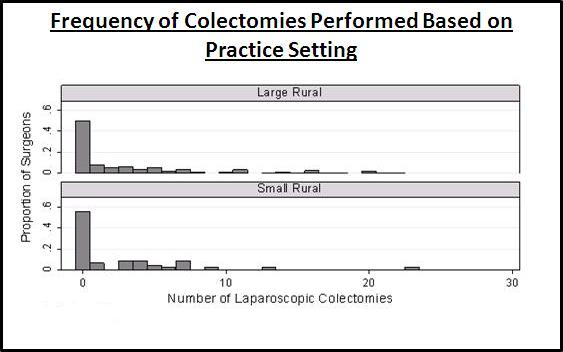Back to 2014 Annual Meeting Posters
Laparoscopic Colectomy and the Rural Surgeon
*Andrew Pellet, *Jesse Moore, Neil Hyman
University of Vermont/Fletcher Allen Health Care, Burlington, VT
Objective: Laparoscopic colectomy is associated with better secondary outcomes such as decreased length of stay and less analgesic requirements than its open counterpart. Multiple studies have suggested a learning curve of 30-50 cases. The aim of this study was to analyze the volume of colon resections performed by surgeons in rural practice.
Design: Retrospective cohort
Setting: 2012 American Board of Surgery MOC applicants
Subjects: General surgery recertification candidates
Main Outcome Measures: Case volume of open and laparoscopic partial colectomies, population density codes.
Results: 197 surgeons were classified as practicing in a rural setting (large rural-150, small rural-47). The median open partial colectomy frequency for large rural surgeons was 7.0 cases (mean 8.1, range 0-46) and 4.0 (mean 6.6, range 0-34 cases) for small rural surgeons. Median annual partial laparoscopic colectomy volume was 1.0 (mean 3.5, range 0-25 cases) for large rural surgeons and 0.0 (mean 2.5, range 0-23 cases) for small rural surgeons (Figure 1). Approximately ½ of surgeons in both groups did not perform a laparoscopic partial colectomy.
Conclusions: Industry and financial pressures to promote laparoscopic colectomy may not promote optimal patient outcomes in rural settings, as safety concerns may outweigh the modest benefits of the procedure. Although referral to remote high volume centers could be advocated, the need for rural general surgeons to perform urgent colectomy for acute indications and the desire of many patients to have care close to home must also be considered.

Back to 2014 Annual Meeting Posters

